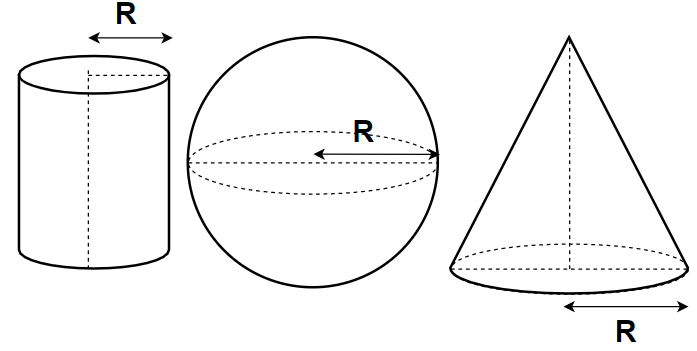
A cone, a hemisphere and a cylinder stand on equal bases of radius R and have the same heights H. The whole surface area in the ratio ?
A. $(\sqrt 3 + 1):3:4$
B. $(\sqrt 2 + 1):7:8$
C. $(\sqrt 2 + 1):3:4$
D. none of these


Answer
573.3k+ views
Hint: In this problem we will use the equation as the radius and height of the hemisphere are equal to each other, so we can measure the total surface area of a cone, a hemisphere and a cylinder separately and eventually find the ratio.
Complete step by step answer:
Since the argument that a circle, a globe, and a cylinder stand on equal R-radius bases and have the same H-heights.
Here it can be observed that the radius and height of a hemisphere are equal,
so, $R = H - (1)$
This means that the circle, hemisphere and ring are equal in height and radius.
Now we'll measure the total cone, hemisphere and cylinder surface area
Height of slant= $\sqrt {{H^2} + {R^2}} = \sqrt 2 R$
As we know the total cone surface area is given as =
$\pi R(L + R) = \pi R(\sqrt {2R} + R) = (\sqrt 2 + 1)\pi {R^2}$
For hemisphere , total surface area is given as $3\pi {R^2}$
From equation 1 we will substitute the value of H
$2\pi R(R + H) = 2\pi R(2R) = 4\pi {R^2}$
Now for cylinder, total surface area is given as
$4\pi {R^2}$
Now we will calculate the ratio, so we get
Total surface area of cone : total surface area of hemisphere : total surface area of cylinder
$ $$(\sqrt 2 + 1)\pi {R^2}:3\pi {R^2}:4\pi {R^2}$
By solving it we get
$(\sqrt 2 + 1):3:4$
Hence the correct answer is option C.
Note:
A cone is a three-dimensional geometric shape that smoothly tapers from a flat base to a point called the apex or vertex. A cylinder has historically been a three-dimensional solid, one of the most fundamental of curvilinear geometric shapes.
Complete step by step answer:
Since the argument that a circle, a globe, and a cylinder stand on equal R-radius bases and have the same H-heights.
Here it can be observed that the radius and height of a hemisphere are equal,
so, $R = H - (1)$
This means that the circle, hemisphere and ring are equal in height and radius.
Now we'll measure the total cone, hemisphere and cylinder surface area
Height of slant= $\sqrt {{H^2} + {R^2}} = \sqrt 2 R$
As we know the total cone surface area is given as =
$\pi R(L + R) = \pi R(\sqrt {2R} + R) = (\sqrt 2 + 1)\pi {R^2}$
For hemisphere , total surface area is given as $3\pi {R^2}$
From equation 1 we will substitute the value of H
$2\pi R(R + H) = 2\pi R(2R) = 4\pi {R^2}$
Now for cylinder, total surface area is given as
$4\pi {R^2}$
Now we will calculate the ratio, so we get
Total surface area of cone : total surface area of hemisphere : total surface area of cylinder
$ $$(\sqrt 2 + 1)\pi {R^2}:3\pi {R^2}:4\pi {R^2}$
By solving it we get
$(\sqrt 2 + 1):3:4$
Hence the correct answer is option C.
Note:
A cone is a three-dimensional geometric shape that smoothly tapers from a flat base to a point called the apex or vertex. A cylinder has historically been a three-dimensional solid, one of the most fundamental of curvilinear geometric shapes.
Recently Updated Pages
Master Class 10 General Knowledge: Engaging Questions & Answers for Success

Master Class 10 Science: Engaging Questions & Answers for Success

Master Class 10 Social Science: Engaging Questions & Answers for Success

Master Class 10 Maths: Engaging Questions & Answers for Success

Master Class 10 English: Engaging Questions & Answers for Success

Master Class 10 Computer Science: Engaging Questions & Answers for Success

Trending doubts
The shortest day of the year in India

Why is there a time difference of about 5 hours between class 10 social science CBSE

Write a letter to the principal requesting him to grant class 10 english CBSE

What is the median of the first 10 natural numbers class 10 maths CBSE

The Equation xxx + 2 is Satisfied when x is Equal to Class 10 Maths

State and prove converse of BPT Basic Proportionality class 10 maths CBSE




